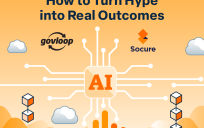For government agencies, artificial intelligence (AI) has the potential to be transformative, providing an unprecedented leap in the ability to manage operations, deliver services and support the mission. But like any new technology, AI requires the right platform. In particular, agencies need to ensure that they don’t lock themselves into a proprietary platform that puts unnecessary constraints on their initiatives.
That is why open source is critical to the future of AI and machine learning (ML). To learn more about the intersection of open source and AI, we spoke with Chris Sexsmith, Cloud and AI/ML Field Strategy Lead for the Public Sector at Red Hat, an open source software solutions provider. He talked about three primary benefits of deploying AI on an open source platform.
1. Increasing the transparency of AI
Open source helps remove the opacity from AI, Sexsmith said. This is important because as data science progresses, data and code become increasingly entangled. That makes it very difficult to understand how an AI system reached a given conclusion – in which case, people are less likely to trust the output. A proprietary platform only exacerbates the problem, Sexsmith said.
“Proprietary code might execute the task marvelously, but when it comes to auditing that entire process, it becomes much more difficult to explain how it came to the conclusion that it came to,” he said. “If you can’t see the code, it becomes more difficult to explain the system as a whole.”
2. Democratizing AI
One reason AI is coming of age now is that the underlying technology is there to support it. The industry is at a technological maturity level that allows accelerators such as graphics processing units (GPUs) to be made accessible to all without breaking the bank, Sexsmith said.
“Openshift, via Kubernetes, enables GPUs to be distributed at a granular level to AI/ML workloads and consumed by teams in an as-a-Service model,” he said. “Optimizing these limited resources allows existing data science teams to do more with less, thereby freeing up budget to do more data science.”
By spending money on data science, rather than the underlying technology, agencies can put the technology in the hands of more data scientists and extend AI’s reach.
3. Extending the DevOps mindset to data, ML
DevOps changed software by bringing together the development and operations teams to work together in a consistent, shared framework. But it’s even more important to add data to the mix, Sexsmith said.
“Code itself doesn’t do much with data, so it’s critical for us to think of data/code entanglement as a living, breathing organism,” he said. “If the data is old or incomplete, or if we don’t fully understand what that data signifies, even the best code in the world will yield meaningless results.”
From its earliest days, open source software has served as a platform not just for technology but for a culture of collaboration. That culture will be vital to the development of AI, Sexsmith said.
This article is an excerpt from GovLoop’s recent guide, “Beyond the Hype: Your Emerging Tech Playbook.” Download the full guide here.





Leave a Reply
You must be logged in to post a comment.